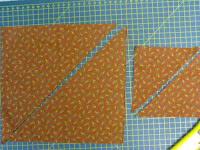I have given myself until the end of February to complete the appliqué on the Jacobean panels and I am on course to do just that. I had intended to enter it into Quilts UK in May, the first of our annual UK competitions. As there is still so much decorative stitching, quilting and finishing to do, I have decided to bide my time and enjoy the sewing journey. What’s the point of rushing and putting myself under a lot of pressure? I have spent a quilting career of manically sewing and writing to deadlines, and now the time has arrived to chill. I can’t believe how good that makes me feel!
Much of my quilting time this week has been devoted to making a project for a magazine article. My new book, Dual Image Appliqué, needs to be promoted. A good way to do this is to send a copy to each of the magazines for review. I usually go one extra step and design an exclusive pattern for a project to accompany the review. This project draws attention to the book and introduces the basic method therein and those interested in developing the method just may purchase the book (fingers crossed!)
Here is the pair of cushions soon to be featured in Patchwork and Quilting magazine.
Patchwork and Quilting project
The technique is simple and the step-by-step method is logical. For these cushions I have used plain squares for the fusing, cutting and sewing and the results are sharp and dramatic. This pattern is a variation of a similar block used in my book and you only have to see what exciting results can be produced with the same method when the starting square is made up of 4 triangles.
Quilt blocks using a constructed square
I loved it so much that I went onto make a full sized quilt. Willow did the snuggle test and approved! I have to say that the palette used for this quilt is one of my favourites. I have always loved strong colour and have learned over the years as a homeowner, that if your walls are soft and neutral, you can use vivid quilts to create interest.
Snuggle test by Willow





















